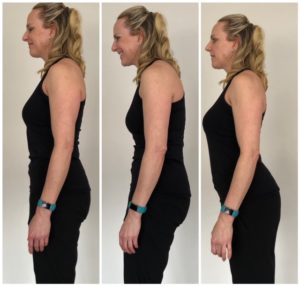
In our movement rehabilitation programs and our classes, we emphasize the importance of maintaining neutral spine. But what does that mean?
A healthy spine has natural curves in it which developed during childhood. Picture the spine as a shape of an ‘S’. The neck and low back naturally has curves called a lordosis. This curves goes inward and is normal. The normal curvature in the thoracic spine, or mid back, is called a kyphosis and it curves outward.
The normal healthy curves of the spine are essential for shock absorption and distribution of forces during movement. These curves are normal but when they are excessive they are called hyper-lordotic or hyper-kyphotic. Sometimes, the curves become flattened. Either too much or too little curvature will affect the spine.
What does Neutral Spine look like?
The best way to visualize and work with the position of the spine is through the pelvis. The way the pelvis tilts directly affects the position of the spine. If the pelvis tilts too far forward, called an anterior tilt, there will be an increase in lumbar spine lordosis. Conversely, if the pelvis tilts too far back, called a posterior pelvic tilt, the lumbar spine lordosis will flatten.
Why is Neutral Spine important?
When the spine is in neutral, the muscles are able to optimally activate to provide the best strength and stabilization of the low back. The joints are in the optimal position for proper distribution of weight. This helps to decrease wear and tear of the discs between the vertebrae and the facet joints between the vertebrae. Wear and tear of the discs and joints of the vertebrae may cause arthritic changes and eventually pain due to inflammation.
How to find Neutral Spine?
For mild low back discomfort or tiredness, often repositioning the pelvis and spine into a neutral position may make the low back area less tight. You may even have immediate relief from mild pain, if this pain is due to positioning of the spine.
In standing:
- standing comfortably in front of a mirror – with feet straight and about fist-width apart
- place your hands on your hips, find the very top of your hip bones and place the space between your thumb and forefinger there, turn your hands so palms are kind of parallel to the ground.
- tilting your hips back and forward. Perhaps think about sticking your buttock out or tucking your buttock under. Your legs should be relatively stationary.
- A neutral spine is a position where your hands should be rather flat.
Another way to feel neutral spine is to do it in lying. Here is a video to explain getting into neutral spine:
Is being in Neutral Spine Uncomfortable?
As with any other part of your body, when you start to move it and position parts in ways it is not used to, there may be discomfort to start off with. If you have been used to a certain posture such as prolonged sitting, some of your trunk muscles may be overly weak and tight while other muscles may be overused. So in adopting a new position, these muscles are unable to maintain and support a neutral spine alignment.
As well, your habitual posture may have created chronic tension in your back, shoulders, or pelvis. This tension caused by tightness might make it initially difficult to get into a neutral spine alignment.
The discomfort caused by weakness or tightness, although uncomfortable at first, is not harmful. It may just mean you need to take some time to lengthen and strengthen the soft tissue around the spine to get into and maintain this position for any extended periods of time.
Interested in learning more on how to prevent low back pain? Try our Learn Pilates Class! Call us or email us for further details!

